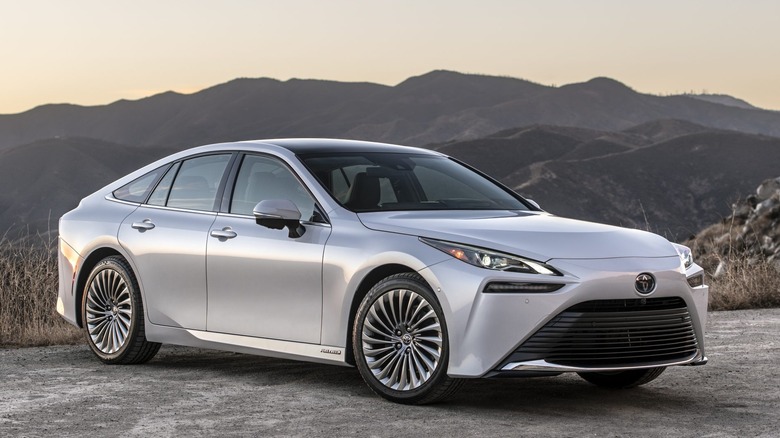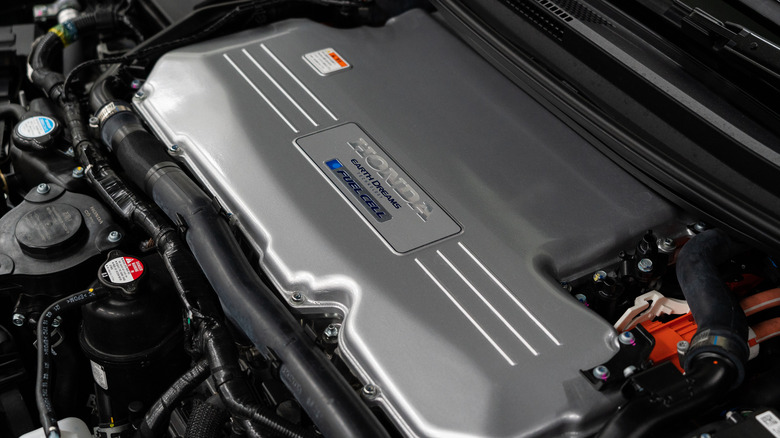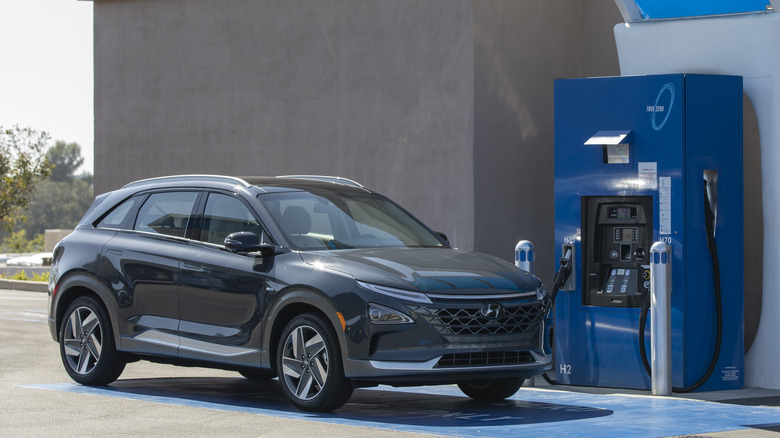Pros & Cons Of Hydrogen Powered Vehicles
There has been a huge amount of news about all aspects of the coming transition to electric vehicles (EVs). In addition to this general awareness, around three million EVs have been sold so far in the U.S. But there is another, lesser-known clean vehicle technology that has support from some of the world's major automakers. This system uses hydrogen to power vehicles.
The first practical use of hydrogen as a vehicular power source was in 1860, when the three-wheel Hippomobile was created by Belgian inventor Etienne Lenoir. Lenoir sold around 400 of these hydrogen-powered vehicles before the first gasoline-powered vehicle, the 1886 Benz Motorwagen, came along. Lenoir's Hippomobile actually electrolyzed water to create the hydrogen that was then burned to power the car's engine. Other attempts to power vehicles with hydrogen have included using the hydrogen in place of gasoline in conventional internal combustion engines (ICE). The U.S. space program accelerated the development of fuel cells in the early 1960s. These fuel cells are still used today to provide space crews with drinking water.
Today's hydrogen fuel cell electric vehicles (FCEVs) use highly pressurized hydrogen as their fuel. The hydrogen is fed into a fuel cell, which combines the hydrogen with oxygen from the air to produce electricity. From this point on, the rest of the vehicle is similar to an EV, with an electric motor providing power to propel it down the road. The main difference between an FCEV and a standard EV is that the FCEV does not need a heavy battery that takes a while to charge. Another difference is that the FCEV's "exhaust" is made up solely of water vapor, which is not harmful to the environment and also explains its use in space travel.
The pros of hydrogen powered vehicles
There are many benefits to hydrogen-powered vehicles. Compared to the much longer charging times required for battery EVs, FCEVs can be fueled just as quickly as ICE vehicles. The process is similar to fueling up with gasoline, except that the hydrogen is a highly compressed gas. Another advantage is that hydrogen-powered vehicles have a long range. The typical FCEV has a hydrogen tank adequate for a 300-400 mile range, which puts the FCEV ahead of all but the most expensive EVs that have a very large (and very heavy) battery.
In terms of environmental benefits, hydrogen is an inherently clean fuel. Pure hydrogen gas, unlike gasoline, has no carbon in it, and therefore produces no CO2 or other emissions. As mentioned above, its only byproduct is water vapor, a totally harmless substance.
Hydrogen power also shines as an ideal fuel for large transport vehicles. For vehicles that move goods, like over-the-road trucks, hydrogen is a choice that makes great sense. Instead of a super-heavy battery that cuts into a truck's payload capacity, a lightweight fuel cell that runs on hydrogen eliminates this limitation. An FCEV truck can carry just as much freight as an ICE truck, but with zero tailpipe emissions. The quick refueling advantage of hydrogen over an EV also applies here.
The cons of hydrogen powered vehicles
There are quite a few downsides to hydrogen-fueled vehicles. At this point in time, there are only three FCEVs available in the U.S. and they can only be purchased in California. They are the Honda CR-V e:FCEV, the Hyundai Nexo, and the Toyota Mirai. BMW has made some X5 FCEVs, but they will be used as technology demonstrators, not production vehicles. Another is the minimal hydrogen fueling infrastructure, which is the real problem with owning and operating an FCEV — Even in California, the only state where FCEVs are sold, hydrogen fueling stations are few and far between. There are now only 55 locations in the entire state to refuel your hydrogen-powered car. This does not inspire confidence in prospective FCEV buyers.
To make hydrogen a truly clean fuel, there will need a cheap and plentiful supply of "green" hydrogen that is produced using renewable energy before it can be considered a clean, carbon-free fuel. The vast majority of the hydrogen produced today is "gray," "brown," or "black" hydrogen, which is made by using fossil fuels. As you might expect, "green" hydrogen costs much more to make than the fossil fuel-based versions, raising fuel costs for consumers significantly above the cost of recharging an EV in your garage overnight.
All of these limitations make it tough for FCEVs to succeed. With single-state availability, very few FCEVs available, not many places to refuel, and a lack of "green" hydrogen, FCEVs are unlikely to be most people's next vehicle. Hydrogen has potential for trucks, but lots of hydrogen infrastructure will need to be built out around the country to make it feasible. For most of us, a battery-powered EV is much more likely to be a future vehicle choice.


